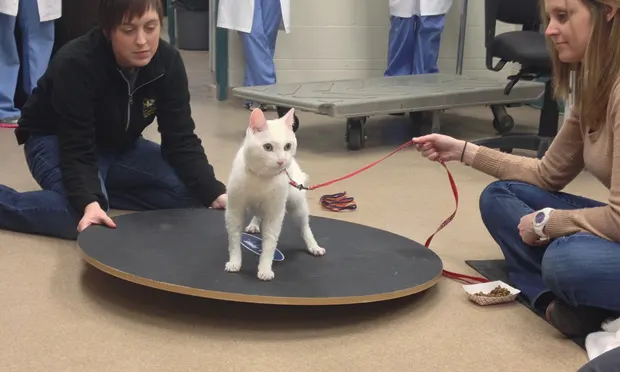Rehabilitation Techniques for the Veterinary Technician
Adrienne D. Siddens, RVT, CCRP, University of Missouri

Image above. A balance board can be used to improve function, strength, joint mobility, and limb use.
Veterinary technicians can increase their value to a practice by becoming proficient in basic physical rehabilitation skills and working with veterinarians to develop and run a rehabilitation program. Although it is often possible to improve a patient’s mobility, function, and comfort without advanced training or costly equipment, some patients are best served by an individual with advanced training and certification in physical rehabilitation.
Related Article: How to Implement a Physical Rehabilitation Program into Your Practice
Physical Rehabilitation Goals
Physical rehabilitation aims to restore, maintain, and promote a patient’s function and quality of life. Rehabilitation is most commonly used following orthopedic and neurologic surgeries, for weight loss, for strengthening and conditioning, and to manage chronic conditions such as osteoarthritis or degenerative myelopathy. Specific areas include range of motion, proprioception and balance, and strengthening exercises, as well as patient assessment.
Related Article: Educating Clients about Arthritis in Pets
Range of Motion Exercises
Range of motion (ROM) exercises are the most basic and fundamental part of a rehabilitation plan. The goals are to maintain or increase joint ROM and optimize muscle flexibility. ROM exercises can be executed either passively or actively.

Passive ROM exercises manually exercise joints through their natural pain-free range without voluntary muscle contraction (Figure 1). They are typically performed in patients with stiffness secondary to surgery or in weak patients unable to walk on their own.
Active ROM exercises put joints through active muscle contraction. Activities include using cavaletti rails (ie, a system of rails placed at adjustable heights and widths); climbing stairs; swimming; and walking in water, sand, or tall grass.
Figure 1. Passive range of motion exercises extend joints in patients who have stiffness following surgery or from joint illness.
Proprioception & Balance Exercises

Proprioception (ie, awareness of body position) and balance may be acutely diminished following surgery, or may gradually decline as a patient ages and chronic conditions worsen. For example, decreased or absent proprioception is common with neurologic conditions affecting the spinal cord. Well-structured exercise plans and strength training activities can help improve a patient’s balance. Tools and exercises to improve proprioception and balance include cavaletti rails (Figure 2), a balance board (see main photo), exercise balls, cone weaving, walking on an air mattress, and basic weight-shifting drills. Proprioception and balance can be incorporated at low cost into an exercise plan and can form a good foundation for increasing function, strength, joint mobility, and limb use.
Figure 2. Exercise with cavaletti rails can help improve proprioception and range of motion.
Strengthening Exercises

Strengthening exercises are employed after a solid base of ROM, consistent limb use, proprioception, and balance has been established. Exercises include walking up and down an incline, climbing stairs, dancing (Figure 3), wheelbarrowing, swimming, pulling or carrying weight, jogging, and moving from sitting to standing. Note that several of these activities can also improve ROM and balance. However, although each exercise may cover several purposes, the frequency and intensity can change the result. For example, stair climbing is a great active ROM exercise when performed at low repetition; increasing the steepness and frequency adds the strengthening component.
Figure 3. Dancing is one type of strengthening exercise.
Patient Assessment

Objective data are needed to measure patient progress toward rehabilitation goals. Required tools include a spring-loaded cloth tape measure, goniometer, and leash. Use the tape measure to quantify muscle mass of the pelvic limb by measuring the thigh circumference 70% distal to the hip (Figure 4); this will measure the mass of the quadriceps and hamstring muscle groups. Using the same technique each time is important. Taking measurements every 2 weeks and recording the results to track progress is recommended.
Figure 4. Muscle mass of the pelvic extremity can be quantified by measuring the thigh circumference 70% distal to the hip.
Use a goniometer to measure and compare flexion and extension angles of affected joints with those of normal joints (Figure 5). When measuring ROM, the joint should be slowly flexed to its comfortable limit and the angle recorded (Table 1). The process is then repeated in extension. Animals do not typically bear weight at the maximum joint angles, so measuring extreme angles is not necessary for rehabilitation purposes.

Figure 5. A goniometer can be used to measure flexion and extension angles.
Observe the patient’s gait at both a walk and a trot to assess for lameness; if lameness is noted, quantify the condition by assigning a score. One helpful lameness scoring method is based on the 0–5 scale (Table 2). Assess the patient weekly and note any changes.
Through the practice of these skills and with minimal and inexpensive equipment, a motivated technician can help develop a physical rehabilitation program that can tremendously benefit his or her practice and patients.
Biomechanics of rehabilitation. Weigel JP, Arnold G, Hicks DA, Millis DL. Vet Clin North Am Small Anim Pract 35:1255-1285, 2005.
Physiotherapy and physical rehabilitation. BSAVA Manual of Canine and Feline Rehabilitation, Supportive and Palliative Care: Case Studies in Patient Management. Lindley S, Watson P—Quedgeley, Gloucester: British Small Animal Veterinary Association, 2010, pp 107-112.